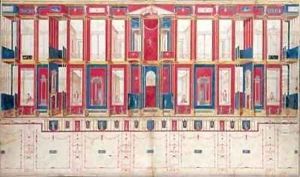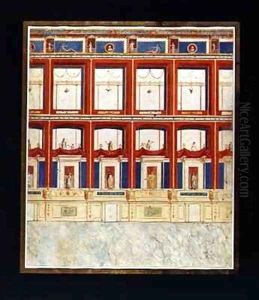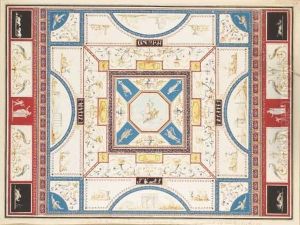Vincenzo Brenna Paintings
Vincenzo Brenna was an Italian architect, painter, and interior designer, whose work has left a significant mark on the landscape of Russian neoclassical architecture. Born in Florence, Italy, in 1745, Brenna's journey into the world of art and architecture began in his native country, but his most influential work would eventually be realized far from home, in Russia. Brenna's early life and education in Italy provided him with a solid foundation in the arts, but details about his initial training and influences remain relatively sparse.
Brenna moved to Russia in the late 18th century, where he quickly became a key figure within the circle of architects and artists serving the Russian elite, including the powerful and influential Catherine the Great. It was in Russia that Brenna's talents truly flourished, as he engaged in a wide array of projects ranging from designing grand palaces to creating intricate interior decorations. One of his most famous works is the grand reconstruction of the Grand Palace in Pavlovsk, near Saint Petersburg, for Paul I of Russia. Brenna's work on the palace is a testament to his skill in blending the grandiose scale of Russian architecture with the elegance and precision of the neoclassical style.
Throughout his career in Russia, Brenna also contributed to the artistic and architectural developments in and around Saint Petersburg, including work on the Mikhailovsky Castle and various other important buildings. His style, characterized by a meticulous attention to classical detail and harmony, significantly influenced the direction of Russian architecture and design during the late 18th and early 19th centuries.
Brenna's influence extended beyond architecture to interior design, where his innovative use of space, color, and ornamentation set new standards. His ability to create visually stunning and harmonious interiors was matched by few during his time. Despite his Italian origins, Brenna's work in Russia has made him a pivotal figure in the history of Russian art and architecture.
Vincenzo Brenna's career in Russia eventually came to an end with his death in 1820. Despite the challenges of working far from his homeland, Brenna's legacy as an architect and designer remains firmly entrenched in the architectural history of Russia. His work not only reflects the artistic exchanges between Italy and Russia during his lifetime but also showcases the universal appeal of neoclassical aesthetics. Brenna's contributions to the arts continue to be celebrated for their innovation, beauty, and lasting impact on the world of architecture and design.





